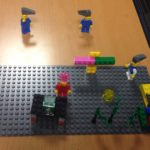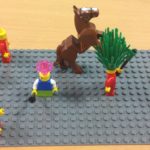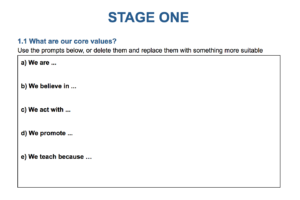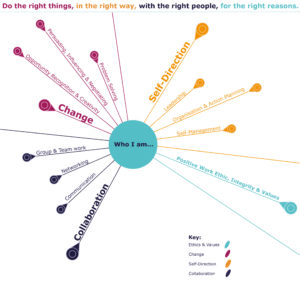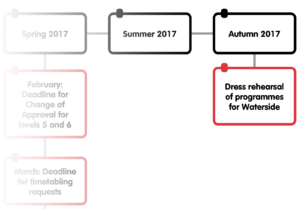 At the recent Learning and Teaching Conference, the Learning Design team hosted a ‘cracker barrel’ table to help staff think about how to approach course (re)design. Those that came to the session were also given an action planner document, which included key dates in the academic calendar between now and the autumn term 2017, when most programmes will be expected to be running in a format appropriate to Waterside delivery.
At the recent Learning and Teaching Conference, the Learning Design team hosted a ‘cracker barrel’ table to help staff think about how to approach course (re)design. Those that came to the session were also given an action planner document, which included key dates in the academic calendar between now and the autumn term 2017, when most programmes will be expected to be running in a format appropriate to Waterside delivery.
For anyone that missed the session, you can find the planner here: Planning for Waterside timeline (PDF, 275KB)
If you would like any help with your planning, please contact the Learning Designers at LD@northampton.ac.uk.
At recent events, including last week’s Learning and Teaching conference, the Learning Design team have been trying out some new activities to help teaching staff think about how they design for learning. You may have seen some of these new tools and activities described in earlier posts in this category, or had the chance to have a go at using them in development events. In this post I’d like to look at the bigger picture of how these might fit together with some of the other services we offer.
At the conference, we hosted a ‘cracker barrel’ table. The staff that came to see us were offered giant post-its (no small motivation!) in exchange for drawing us a picture of what they value most in their teaching. You can view these in our online album here (we’ll be adding more from other events to this album too):
 |
| What I value most in teaching |
The resulting images were not just works of art. They could also be seen as ‘teaching metaphors’ (McShane 2005). We asked participants to expand on these, and break down what was happening in the image using three key questions:
- what is the role of the tutor?
- what is the role of the student?
- what is the role of technology?
Common themes in the role of the tutor included motivation, guidance, facilitation and enabling, linking learners together and lighting ‘sparks’ and ‘light bulbs’ of understanding. There was also an emphasis on pastoral roles, being ‘approachable’, ’empathetic’ and a ‘confidant’. The role of the student was widely agreed to be participative, with comments noting the importance of engaging, contributing and becoming autonomous. Some comments also noted that the distinction between tutor and student is not so dichotomous, and that learning happens in a community where the participants all learn together. Comments on the role of technology mostly focused on supporting access to learning, as well as ‘fostering community’ and enabling sharing. You can see all the contributions in this PDF file (3.5MB, captured using the Post-It Plus app).
 Sadly that was all we had time for on the day, but we did ask them to go away and think about how their image related to their own programmes and modules. Is that ideal teaching moment what’s happening in those modules now? And if not, what could they change that might enable them to do more of what they value?
Sadly that was all we had time for on the day, but we did ask them to go away and think about how their image related to their own programmes and modules. Is that ideal teaching moment what’s happening in those modules now? And if not, what could they change that might enable them to do more of what they value?
This led me to think about a model that I had been introduced to by our very own Deborah Forbes, in a staff development session on Thriving in a Changing Environment*. The model is Appreciative Inquiry (AI), and as a positive approach to change management it has a lot to offer as we prepare for Waterside. Here’s what some of the experts have to say about AI:
“The traditional approach to change is to look for the problem, do a diagnosis, and find a solution. The primary focus is on what is wrong or broken …Appreciative Inquiry suggests that we look for what works in an organization …Because the statements are grounded in real experience and history, people know how to repeat their success.” (Hammond, 1998, pp.6-7)
And:
“[Appreciative Inquiry] deliberately seeks to discover people’s exceptionality – their unique gifts, strengths, and qualities. It actively searches and recognizes people for their specialties – their essential contributions and achievements. And it is based on principles of equality of voice – everyone is asked to speak about their vision of the true, the good, and the possible.” (Cooperrider, 2001, p.12)
Although there is no one definitive model for AI, the 4-D aproach is widely used. This consists of four main steps:
- Discover: The identification of organisational processes that work well.
- Dream: The envisioning of processes that would work well in the future.
- Design: Planning and prioritising processes that would work well.
- Destiny: The implementation (execution) of the proposed design. (Cooperrider and Whitney, 2005, p.17)
In terms of programme and module design, the steps we covered at the conference were targeted at the ‘discover’ and ‘dream’ stages – by helping staff to think about what works really well for them and their students, they can begin to think about what their programme or module might look like if they did more of it. This begins a process that then feeds in to the beginning of the CAIeRO, where staff are asked to outline their aims for the programme or module, create a mission statement for it, and think about the ‘look and feel’ (see this post for more on this). The CAIeRO process then leads the course team through the ‘design’ stage towards the ‘destiny’ or delivery of the new or re-designed modules.
Do you have positive stories to share about what you love about teaching, what’s working well, and what it should look like in the future? Would you like to contribute to the conversation? Then why not add your comments, send us a picture (along with a brief outline of what’s happening), or write us a case study? You can comment on this post, or email the Learning Design team at LD@northampton.ac.uk.
References:
Cooperrider, D.L. (2001) Why Appreciative Inquiry? In Cooperrider, D.L., Hammond, S. and Royal, C. (eds) Lessons from the Field: Applying Appreciative Inquiry. Plano: The Thin Book Publishing Company.
Cooperrider, D.L. and Whitney, D (2005) Appreciative Inquiry: A positive revolution in change. San Francisco: Berrett-Koehler.
Hammond, S. (1998) The Thin Book of Appreciative Inquiry. Plano: The Thin Book Publishing Company.
McShane, K. (2005) Metaphors for University Teaching. Learning and Teaching in Action. 4(1). Available from: http://www.celt.mmu.ac.uk/ltia/issue10/mcshane.shtml [Accessed 29th May 2015]
* Look out for future sessions on the Staff Development site on NILE (note, you will need to be logged in to NILE for this link to work).
Or, how can Lego help you to build a course or module?
Introduction to Programme Design is a one hour staff development session for new academic staff. The session covers key information that staff need to know about how programme and module design works at the University, including signposts to the frameworks and regulations and an overview of the support available.
To help staff start thinking about the complexity of course design, we gave them some lego and asked them to work in pairs to think about the elements that need to be considered, and how they relate to each other.
Why lego?
Why not? Lego is a simple to use, non-threatening tool that helps to externalise people’s ideas in a visual way. It provides a framework for storytelling, and as you will see from the results below, can help teams to synthesise and communicate big ideas. It’s used in many companies as part of a design thinking approach, to help find creative solutions to complex problems*.
Here are some of the elements that Lego helped us to discuss. Each team was given a standard set, along with a single ‘random’ piece. Click on the thumbnail images to view the full scenes:
This team used the lego to show the lecturer and students working within and co-creating a framework, which included other elements like NILE and QAP. The bridge between the students indicates social learning. The scene also includes ‘steps to success’ and a diving board to launch them into their career. The little eyes indicate institutional oversight, and the web is used to catch the students who are not engaged and enable them to ‘bounce’ back in to the course.
This scene has a student at the centre, as the course design starts from their expectations and needs. Alongside the student is an academic and a member of support staff, indicating working in partnership. The shark is about risk: in the form of competition from other universities, and of distractions from learning – the wall is a protection against this. The raised platform indicates student support, including academic standards, facilities like NILE and IT, and skills for employability.
Stakeholders in this scene include service users and commissioners, who are central to programme design for Health courses, as these must consider the needs of the local area in terms of health provision. Other elements include the resources available (lecturers, skills), and the constraints e.g. professional body regulations and quality frameworks. The elephant is Waterside, which will have a ‘massive’ influence on how we move forward with programme design.
The students in this depiction were widely scattered around the room, indicating the ‘geographically dispersed nature of learning communities’. They are connected by mobile devices. The staff member has a movable ‘office’ (which could be at home, a hotdesk, overseas etc). There are signposts for learners throughout the course. The purpose of the course is to help students achieve educational, career and social mobility, indicated by climbing the ladder.
In this scene, the students (on the left) arrive at different levels and some progress faster than others. The programme lead is looking towards them to help them progress. Ahead is the University management and governance, leading the direction of the University. The horse is University strategy, leaping obstacles and providing support to students. On the right is a platform – both for celebration of success (award ceremony) and as a launchpad to a career.
The exercise helped participants to start thinking about the stakeholders that need to be considered in programme design, the aims of their programme or module, and the ways that students are supported. The discussions showed the complexity of the course design process, and shaped our conversations about how it should be supported.
If you were in this session and would like to expand on your model, or if you weren’t but you’d like to respond to the models (or create your own!), please leave us a comment below.
To sign up for a session, visit the Staff Development organisation on NILE (note: you will need to be logged in to NILE for this link to work).
*Although we didn’t have time to use it in this session, the Lego Serious Play website outlines a full methodology for this approach.
Our colleagues at CfAP are often on the receiving end of poor assessment design. In this post, Kate Coulson, Head of CfAP, describes the impact on the student experience and looks at ways to ensure this won’t happen to your students…
“Maya* is an undergraduate in the second year of her degree. Throughout her first year, she was averaging a C grade in her assessments. Maya has just received her grade and feedback from her first assessment of her second year. She was given a D grade and the marking tutor advised her to visit CfAP to get some support and guidance in “understanding the question”.
When Maya meets with a CfAP Tutor she becomes very distressed and states that “the question didn’t make sense” and “I don’t know what I needed to include”. She also states that she spoke to her tutor directly as she was unclear about the assessment but their conversation left her more confused. When chatting to her course mates about the assessment, they had interpreted the requirements in a totally different way and she panicked and didn’t know what to do.”
When writing questions for essays or assignments it is imperative that you think about the student. Badly written essay questions confuse the student and can affect their confidence and performance in the task – sometimes even leading them to question whether University is the right place for them.
Tips to help you avoid the pitfalls:
- Allow time to plan your questions or tasks.
- Be clear about what knowledge and skills you want the students to demonstrate (these should be informed by your learning outcomes).
- When you are writing a question or task, consider the stage of the programme and module where it takes place, and evaluate whether the students have the content knowledge and the skills necessary to respond adequately.
- When scheduling, be aware of other assessments students will be given from other modules on the programme. Nobody benefits from students having to divide their time and energy between multiple deadlines.
- Discuss the assessment with your students – both the task itself and the purpose of it. Explaining why you have chosen this task, and how it will help them to reach the learning outcomes, will help them feel ownership. Be prepared to adjust in response to valid feedback.
- Share grading criteria and rubrics ahead of the assessment. Students should know what they are aiming for, and what satisfactory performance looks like. Better still, consider writing a model answer. This will help you to reflect on the clarity of the essay question, even if you choose not to share it with the students until after the deadline. It could also serve to inform the grading of students’ responses.
- Use your colleagues to critically review the question or task, the model answer and the intended learning outcomes for alignment.
- Use formative tasks to help students to develop their understanding of expectations and standards. Better still, plan out the ‘assessment journey’ when planning your module, to ensure students have opportunities to learn the process as well as the content of the assessment. The Assessment and Feedback cards from the JISC Viewpoints project can help you do this.
Writing good essay questions is a process that requires time and practice. Review your questions after the students have completed them, think about how the questions have been interpreted. Studying the student responses can help evaluate students’ understanding and the effectiveness of the question for next time.
Useful reading and resources:
The University’s Assessment and Feedback Portal provides more information about assessment design, including links to published research in this area.
The Assessment Brief Design project from Oxford Brookes gives detailed guidance on writing clear and targeted briefs.
For more on the great work done by the Centre for Achievement and Performance, visit the CfAP tab on NILE.
*”Maya” is a fictional character, although her story is based on real events.
Dr Estelle Tarry outlines the development of the URICA Undergraduate Journal, which publishes selected undergraduate dissertations from the Faculty of Education & Humanities.
View the full case study here (PDF, 542KB)
Visit the journal website here: http://bit.ly/URICA
Dr Terry Tudor, Senior Lecturer in Waste Management, introduced structured online learning activities (e-tivities) into his Masters modules after attending a CAIeRO for individuals course development workshop. Read the case study to see how these activities have helped to link his distance learning students with his learners on campus – and also helped them to improve their writing skills.
The first stage of a CAIeRO is all about outlining a vision for the programme or module – what is it for? what do you want it to do? – and then drafting this into something concrete to work on.
 For new programmes, refining the vision or idea is usually the logical place to start; defining the goals and the parameters, in discussion with colleagues on the course team, and with support from learning designers.
For new programmes, refining the vision or idea is usually the logical place to start; defining the goals and the parameters, in discussion with colleagues on the course team, and with support from learning designers.
For existing programmes, this step may initially seem quite straightforward. A quick reference to the programme specification should tell us what we need to know. In practice though, programmes and modules get tweaked and adjusted over time, and for many programme teams it is rare to get the opportunity to spend time sharing ideas about the bigger picture of what should be taught, and how students might learn it. Stage 1 of the CAIeRO is your opportunity to revisit the aims of the programme and do a health check: asking is this still what we want to achieve? And if it is, then is this still clearly reflected in the modules that make up the programme?
As with all of the CAIeRO elements, you may spend more or less time on each task depending on the needs of your programme. That said though, it is always worth taking the time to ensure a shared vision before moving forward.
The mission statement
This first activity asks you to define, as a group and in a limited number of words, the ‘mission’ of the programme. This helps to ensure that everyone in the team is aiming for the same thing, so that we design a consistent experience for the learner. This step is particularly useful for programmes that combine modules from different areas of the discipline, and it allows those leading different modules to share their perspectives and experience. Reaching consensus can sometimes be tricky, but it does make everything that comes afterwards much easier! Once you have this, you can create statements for each of your modules, that align with and develop the mission for your programme.
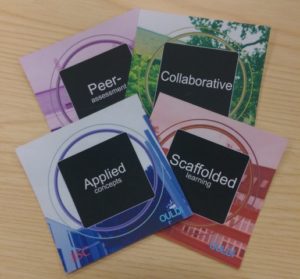 The ‘look and feel’
The ‘look and feel’
This stage of the workshop uses Course Features cards, designed by the Open University Learning Design Initiative. You’ll be asked to narrow down the features to those which are most important to the ‘look and feel’ of your course. This may sound a little ‘woolly’, but it’s an easy umbrella term for the different elements that need to be considered (pedagogic approach, guidance and support, content, interaction and so on).
As with the mission statement, this activity helps the team to work towards a consensus on the type of learning experience you want to create. But there are also other gains to this process, that sometimes go unnoticed:
- It provides a common language to help you and your colleagues talk about how you like to teach – particularly for those teaching strategies that are based on tacit experience. Choosing these stimulates discussion about them: what do you mean by …? how does that work? why is that the best approach? This discussion is useful for skill sharing and personal development, as well as narrowing down the most effective approaches for the context.
- It brings the learners into the heart of the conversation, as choices need to be made about what learning approaches they might use, and what kinds of support they might need.
- It helps to ensure that you are considering all the elements that make up a balanced course.
Constructive alignment and backwards design
 The next three sections or tasks ask you to focus in on the module level, though you will need to keep the programme-level outcomes and assessment map in the back of your mind to ensure alignment. We’ll look at the building blocks that form the basis of each module: the learning outcomes, assessment tasks and learning activities. We’ll be looking to flesh out the initial vision into a more structured pathway that is constructively aligned, asking: how do we define the learning in terms of demonstrable outcomes? how do we design assessment opportunities that allow the learner to demonstrate achievement of those outcomes? how do we create learning activities that support the learner to reach the intended outcomes and succeed in the assessment? For this we often use a ‘backwards design‘ approach, beginning with what we want the learner to know and be able to do at the end of the module, and working backwards.
The next three sections or tasks ask you to focus in on the module level, though you will need to keep the programme-level outcomes and assessment map in the back of your mind to ensure alignment. We’ll look at the building blocks that form the basis of each module: the learning outcomes, assessment tasks and learning activities. We’ll be looking to flesh out the initial vision into a more structured pathway that is constructively aligned, asking: how do we define the learning in terms of demonstrable outcomes? how do we design assessment opportunities that allow the learner to demonstrate achievement of those outcomes? how do we create learning activities that support the learner to reach the intended outcomes and succeed in the assessment? For this we often use a ‘backwards design‘ approach, beginning with what we want the learner to know and be able to do at the end of the module, and working backwards.
First in this sequence are the outcomes (what the student should ‘come out with’, or should know or be able to do). These are arguably the most important element of a module, and not (only) because they are required for quality assurance and benchmarking! Outcomes define the parameters of what will be covered, and help the student to understand what’s expected and what will be assessed. We will check the outcomes for each module against three key criteria: language, academic level, and relation to assessment.
Assessment activities will be chosen or reviewed to ensure validity: what’s the best way for a student to demonstrate these outcomes? We’ll also consider how to prepare the students for the assessment (in terms of process as well as content), and how to incorporate peer and self-assessment.
Finally, we’ll begin to consider what kind of learning and teaching will be needed to support the students in achieving the outcomes. We’ll cover this in more depth in the next section.
A note on paperwork: Any design change to a module needs to work within the relevant quality assurance framework. If you’re working on learning outcomes or assessments, these may already be written in your module specification, and making changes to these could require a change of approval. When designing learning activities, you’ll also need to consider the allocation of teaching, learning and assessment hours that currently make up the workload for that module (200 hours for a 20 credit module). Don’t let QA requirements stop you improving things – your Learning Designer or Embedded Quality Officer can help you to understand the requirements for any suggested changes.
This is one in a series of posts about the CAIeRO process. To see the full list, go the original post: De-mystifying the CAIeRO.
Need a CAIeRO? Email the Learning Design team at LD@northampton.ac.uk.
 CAIeRO workshops are a time-intensive activity, requiring two full days from every member of the team to be most effective. With this in mind, it’s really worth taking the time in advance to agree what the team wants to achieve in that time. The person running the CAIeRO will be a trained facilitator or Learning Designer, and they will always request a pre-CAIeRO meeting, with at least the programme and module leaders but ideally with the whole team.
CAIeRO workshops are a time-intensive activity, requiring two full days from every member of the team to be most effective. With this in mind, it’s really worth taking the time in advance to agree what the team wants to achieve in that time. The person running the CAIeRO will be a trained facilitator or Learning Designer, and they will always request a pre-CAIeRO meeting, with at least the programme and module leaders but ideally with the whole team.
In the pre-CAIeRO meeting we will cover a range of topics including:
- Background to the programme. We’ll need an idea of what the course is about, who the tutors are, who the learners are, mode of delivery etc.
- Why do you need a CAIeRO? We’ll discuss any goals or challenges identified by the programme team that need to be addressed, and also any upcoming QA processes (validation, PSR) that need to be considered.
- What do you know about CAIeRO? We’ll give you an overview of what you can expect, what’s expected of you, and the deliverables.
- What skills and resources do we have available? We’ll review what experience the team has of course design, of teaching on the course, of delivering in the chosen mode, of using NILE etc.
- Who (else) needs to be there? We need at least all the staff on the teaching team. This means those who lead and teach on the modules under review, and ideally also those who teach the other modules in that year or programme. This helps promote a consistent experience from the student perspective, and also allows the shared vision and skills developed to be disseminated to other modules where appropriate. We will also need at least one ‘reality checker’ from outside the team (more on that later). But in order to get the design right, we might also want input from other stakeholders… Students? Academic Librarian? Learning Technologist? Embedded Quality Officer? CfAP? Critical friend? External Examiner? Employer?
- Logistics. When* and where? You’ll need a room with a screen, and with tables for laying out flip chart paper. And although fun, CAIeRO can also be hard work, so don’t forget the coffee and biscuits!
Once we have all the details worked out, your Learning Designer will create a CAIeRO planner document and send out the link to it. This is a working document that we will be using throughout the process. Before the CAIeRO itself, the team can use this document to record their aims for the module, reflections on student feedback, and any ideas or resources they want to include on the day.
*Note: the two days that make up a CAIeRO do not need to be consecutive. There are benefits to keeping the two days together to maintain momentum, but it can also be helpful to leave time in between for reflection, depending on how the team works best. It is important though to put both days in the diary at the beginning. Leaving the second day to be arranged later risks leaving the work half done, despite the best of intentions…
This is one in a series of posts about the CAIeRO process. To see the full list, go the original post: De-mystifying the CAIeRO.
Need a CAIeRO? Email the Learning Design team at LD@northampton.ac.uk.
“I keep hearing about this CAIeRO thing, but I don’t really know what it is…”
 CAIeRO stands for “Creating Aligned Interactive educational Resource Opportunities”. If you’re wondering, yes, there is a theme here. The acronym was chosen (although not by me) to align with the Northampton Integrated Learning Environment (NILE).
CAIeRO stands for “Creating Aligned Interactive educational Resource Opportunities”. If you’re wondering, yes, there is a theme here. The acronym was chosen (although not by me) to align with the Northampton Integrated Learning Environment (NILE).
So what does it actually mean? Think of it as a Course Design Retreat – a full module CAIeRO is two days away from the phone and the email, to build or re-design taught modules, with support from a range of specialist staff. Every CAIeRO will be different, but broadly speaking the workshop has two aims – to develop the modules themselves, and to help the teaching team to develop their course design skills.
This is the first in a series of blog posts examining the different elements of the CAIeRO course design process. The series will cover all of the key interactions, from the pre-CAIeRO meeting through to follow up activities. It will discuss the tools and techniques used in CAIeRO, and their role in course design.
I hope these posts will provide an insight into the process for those that are new to CAIeRO, as well as a reminder for those who have participated in or facilitated sessions. CAIeRO is a work in progress, and we’d love to hear about your experiences, so please feel free to add your own comments, insights and suggestions.
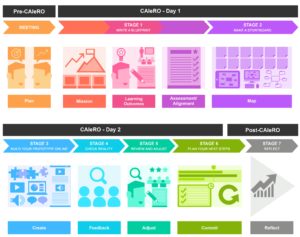 Links to the posts will be added below as they are published. You can also click on the image to see a visual overview of the CAIeRO process.
Links to the posts will be added below as they are published. You can also click on the image to see a visual overview of the CAIeRO process.
De-mystifying the CAIeRO:
- The pre-CAIeRO meeting
- Programme level CAIeRO
- CAIeRO Stage 1: The blueprint
- CAIeRO Stage 2: The storyboard
- CAIeRO Stages 3-5, let’s get building!
- CAIeRO Stages 6 and 7, planning and reflecting
Need a CAIeRO? Email the Learning Design team at LD@northampton.ac.uk.
For more information about the development of the CAIeRO methodology, research into the use of CAIeRO, and guidance on how to become a facilitator, see the Introduction to CAIeRO page on our ILT website.
A typical module CAIeRO will often start with programme level exercises, such as agreeing or reviewing the mission, ‘look and feel’, and learning outcomes for the programme as a whole. It’s in the interests of the teaching team – and the students – to (re-)use these elements of the programme’s blueprint when designing at module level – it helps to promote coherence and consistency, and to minimise unintentional duplication. But focusing on the module level, while necessary for planning and supporting good learning, can sometimes lead to a fragmented approach over time. Sometimes you need to take a step back to see the bigger picture.
The Learning Design team are often asked to support teams who need to review and make changes at the programme level. As with module CAIeROs, the reasons for this can be many and varied: maybe it’s a new programme or pathway; maybe there have been significant changes in staffing or in the subject area; maybe the team want to respond to specific institutional agendas or to challenges identified in student feedback or grades; maybe it’s just been a long time since the programme was reviewed as a whole and the team want to ensure that iterative changes at the module level haven’t affected the coherence of the award map. Programme level CAIeROs can be as diverse and bespoke as module level ones, but there are some common goals, and as a team we are always refining our toolkit to support them. You may find you use some of the steps below more or less depending on your needs, but this post, along with the Programme Planner developed by our very own Rob Farmer, will give you an idea of some of the approaches available to you.
Before you start: (Re)establishing consensus
The programme ‘blueprint’
As always we suggest you start by defining the intended outcomes, if you don’t have these already. Although programme outcomes are slightly different to module outcomes, because they are not directly assessed, many of the same principles still apply. They need to be aligned with national quality standards (e.g. the FHEQ and Subject Benchmark Statements), and with any relevant Professional, Statutory and Regulatory Body (PSRB) requirements if the programme is accredited – and of course they have to make sense to non-experts, including students and employers. Once you have your programme outcomes, you can start thinking about breaking them down into chunks of learning that will form your taught modules – or, for existing programmes, reviewing how well they map to the modules you already have in place. Do you need to add, remove, combine or split anything?
Sequencing learning
 Taking a programme level perspective allows you to plan the development of understanding and skills across a larger timeframe, to make sure that the scaffold is sound and your students aren’t missing a foundation piece when they reach the higher levels. To get the sequence right, you can storyboard your programme using a range of tools, from paper and post-its to Powerpoint or Popplet. Move the pieces around until the order seems logical, and think about whether each piece needs to be ‘short and fat’ (intensive) or ‘long and thin’. At this stage you might want to consider the placement of elements that are more complicated to schedule, like placements and trips, as well as those over which you have no control, like holidays and closed days.
Taking a programme level perspective allows you to plan the development of understanding and skills across a larger timeframe, to make sure that the scaffold is sound and your students aren’t missing a foundation piece when they reach the higher levels. To get the sequence right, you can storyboard your programme using a range of tools, from paper and post-its to Powerpoint or Popplet. Move the pieces around until the order seems logical, and think about whether each piece needs to be ‘short and fat’ (intensive) or ‘long and thin’. At this stage you might want to consider the placement of elements that are more complicated to schedule, like placements and trips, as well as those over which you have no control, like holidays and closed days.
Mapping assessment and feedback
It can be really useful to overlay your assessments on to your programme storyboard, to give you an idea of the mix of assessment activity and also to identify any deadline and marking ‘bottlenecks’. Programme leaders will usually collate details of the summative assessments across a programme, because this information is required for processes like validation, but we would encourage you to do this for your formative assessment opportunities too. This will allow you to easily see the turnaround time and where students will receive their feedback – and to identify whether it is timely enough to be useful for the next summative task! If you don’t know yet how your modules will be assessed, make a note to come back to this step, or keep a ‘work in progress’ version that you can update with more detail as you go on.
Key skills and ChANGE skills
Programme design can be a complex business – and this is before you even get in to the details of the individual modules! We recommend that teams who have a lot to do at the programme level leave at least a full day for this type of work, before moving on to the module level CAIeROs.
This is one in a series of posts about the CAIeRO process. To see the full list, go the original post: De-mystifying the CAIeRO.
Need a CAIeRO? Email the Learning Design team at LD@northampton.ac.uk.
Recent Posts
- Spotlight on Excellence: Bringing AI Conversations into Management Learning
- Blackboard Upgrade – December 2025
- Preparing for your Physiotherapy Apprenticeship Programme (PREP-PAP) by Fiona Barrett and Anna Smith
- Blackboard Upgrade – November 2025
- Fix Your Content Day 2025
- Blackboard Upgrade – October 2025
- Blackboard Upgrade – September 2025
- The potential student benefits of staying engaged with learning and teaching material
- LearnTech Symposium 2025
- Blackboard Upgrade – August 2025
Tags
ABL Practitioner Stories Academic Skills Accessibility Active Blended Learning (ABL) ADE AI Artificial Intelligence Assessment Design Assessment Tools Blackboard Blackboard Learn Blackboard Upgrade Blended Learning Blogs CAIeRO Collaborate Collaboration Distance Learning Feedback FHES Flipped Learning iNorthampton iPad Kaltura Learner Experience MALT Mobile Newsletter NILE NILE Ultra Outside the box Panopto Presentations Quality Reflection SHED Submitting and Grading Electronically (SaGE) Turnitin Ultra Ultra Upgrade Update Updates Video Waterside XerteArchives
Site Admin




